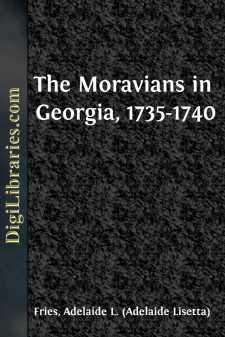Categories
- Antiques & Collectibles 13
- Architecture 36
- Art 48
- Bibles 22
- Biography & Autobiography 813
- Body, Mind & Spirit 142
- Business & Economics 28
- Children's Books 15
- Children's Fiction 12
- Computers 4
- Cooking 94
- Crafts & Hobbies 4
- Drama 346
- Education 46
- Family & Relationships 57
- Fiction 11828
- Games 19
- Gardening 17
- Health & Fitness 34
- History 1377
- House & Home 1
- Humor 147
- Juvenile Fiction 1873
- Juvenile Nonfiction 202
- Language Arts & Disciplines 88
- Law 16
- Literary Collections 686
- Literary Criticism 179
- Mathematics 13
- Medical 41
- Music 40
- Nature 179
- Non-Classifiable 1768
- Performing Arts 7
- Periodicals 1453
- Philosophy 64
- Photography 2
- Poetry 896
- Political Science 203
- Psychology 42
- Reference 154
- Religion 513
- Science 126
- Self-Help 84
- Social Science 81
- Sports & Recreation 34
- Study Aids 3
- Technology & Engineering 59
- Transportation 23
- Travel 463
- True Crime 29
The Moravians in Georgia, 1735-1740
Categories:
Description:
Excerpt
In the life of any individual, association, or nation, there will probably be one or more occurrences which may be considered as success or failure according to the dramatic features of the event and the ultimate results. Of this the Battle of Bunker Hill is a striking example. On the morning of June 17th, 1775, a force of British soldiers attacked a small body of raw, ill-equipped American volunteers, who had fortified a hill near Boston, and quickly drove them from their position. By whom then was the Bunker Hill Monument erected? By the victors in that first engagement of the Revolution? No, but by proud descendants of the vanquished, whose broader view showed them the incalculable benefits arising from that seeming defeat, which precipitated the great struggle, forcing every man in the Colonies to take a position squarely for or against the American Cause, convinced the timid that only proper equipment would be needed to enable the American army to hold its own against the foe, and taught the British that they were dealing, not with hot-headed rebels who would run at first sight of the dreaded "red coats", but with patriots who would stand their ground so long as a charge of powder remained, or gunstocks could be handled as clubs.
Very much the same line of argument may be applied to the first attempt of the Moravian Church to establish a settlement on the American Continent. The story is usually passed over by historians in a few short paragraphs, and yet without the colony in Georgia, the whole history of the Renewed Church of the Unitas Fratrum would have been very different. Without that movement the Moravian Church might never have been established in England, without it the great Methodist denomination might never have come into being, without it the American Moravian provinces, North or South, might not have been planned. Of course Providence might have provided other means for the accomplishment of these ends, but certain it is that in the actual development of all these things the "unsuccessful attempt" in Georgia, 1735 to 1740, played a most important part.
In preparing this history a number of private libraries, the collections of the Georgia Historical Society, the Congressional Library, the British Museum, were searched for data, but so little was found that the story, in so far as it relates to the Moravian settlement, has been drawn entirely from the original manuscripts in the Archives of the Unitas Fratrum at Herrnhut, Germany, with some additions from the Archives at Bethlehem, Pa., and Salem, N. C. For the general history of Georgia, of the Moravian Church, and of the Wesleys, Steven's History of Georgia, Hamilton's History of the Moravian Church, Levering's History of Bethlehem, Pa., Some Fathers of the American Moravian Church, by de Schweinitz, Strobel's History of the Salzburgers, Tyreman's Oxford Methodists, and Wesley's Journal have been most largely used.
The history of the Moravian settlement in Georgia falls into that period when dates are much confused through the contemporaneous use of the old style, or Julian calendar, and the new style, or Gregorian calendar. As the latter is now current everywhere, except in Russia and the Orient, it is here employed throughout, old style dates being translated where they occur in the records.
Special thanks are due to Rev. A. Glitsch, Archivist at Herrnhut, for courtesies extended while the author was examining the invaluable collection of papers entrusted to his care, and also for his supervision of the copying of such documents as were selected; to Mr. Isaac Beckett, of Savannah, for information respecting the Moravian lands; to Mr. John Jordan, of Philadelphia, for copies of deeds and other papers relating to the settlement; to Mr. W. S. Pfohl, of Salem, for assistance with the illustrations; and to Mr. John W. Fries for suggestion and inspiration for the work, and the constant encouragement and sympathetic interest without which the author's courage would have failed during the tedious years of gathering material for the book, which is now presented to those who may find in it something of explanation, something of interest, concerning the Moravian settlement in Georgia, and the broader history which the story touches on every side.
...

